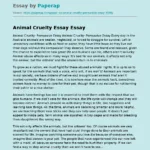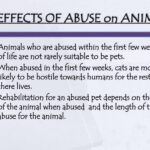Animal cruelty is a pervasive issue that transcends boundaries and affects millions of lives globally. As students and future leaders, it is imperative to understand the intricacies of this problem and develop strategies to combat it effectively. Creating a powerful essay on how to stop animal cruelty is more than just a writing exercise; it is an opportunity to explore ethical considerations, societal norms, and the psychological underpinnings of human-animal relationships. This essay outline serves as a guide for students to construct a compelling narrative that addresses the multifaceted nature of animal cruelty.
Introduction
Begin your essay with a poignant statistic or an emotionally charged anecdote illustrating the rampant nature of animal cruelty. This sets the tone for your discussion. Define animal cruelty, encompassing both intentional acts of violence and neglect, and emphasize its implications on society and the environment. Conclude the introduction with a clear thesis statement outlining the principal strategies that will be explored in the ensuing sections.
Body Paragraph 1: Understanding Animal Cruelty
Begin by delving into the definition of animal cruelty, distinguishing between active cruelty and passive neglect. Provide examples—such as dog fighting or hoarding animals—which highlight the breadth of this issue. Discuss the psychological factors that potentially contribute to human malpractice against animals, including desensitization, cultural influences, and the innate human propensity toward domination. Address the legal frameworks currently in place, underscoring their inadequacies. Evaluate the efficacy of laws concerning animal welfare and position them within the context of societal values.
Body Paragraph 2: The Role of Education
Education holds the key to fostering empathy and compassion towards animals. Discuss the need for incorporating animal welfare education in school curricula. Explain how lessons about animal biology, sentience, and ethics can reshape perspectives. Share insights from successful educational programs that have engaged students in hands-on experiences with animals, thereby cultivating a sense of responsibility and advocacy. Emphasize the role of community outreach programs and workshops that aim to inform the public about observing and reporting animal cruelty.
Body Paragraph 3: Advocacy and Activism
Advocacy plays a crucial role in catalyzing change. Outline various forms of activism—ranging from volunteering at shelters to participating in awareness campaigns. Discuss the impact of social media as a tool for mobilization and awareness. Highlight the importance of petitions and community-driven initiatives that promote stronger animal protection laws. Provide examples of organizations that have effectively leveraged public support to bring about legislative change. Emphasize the importance of grassroots efforts and how collective voices can lead to meaningful reforms.
Body Paragraph 4: The Impact of Industry
A significant contributor to animal cruelty is the various industries that exploit animals. Examine the agricultural, entertainment, and fashion industries, and their role in perpetuating cruelty through practices such as factory farming, animal testing, and the use of fur. Discuss the ethical implications of these practices and the demand for more humane alternatives. Introduce concepts like ethical consumerism, encouraging students to critically assess their purchasing decisions and to support cruelty-free products. Explore the potential for innovative solutions, such as lab-grown meat and faux fur, that could minimize animal suffering.
Body Paragraph 5: The Role of Legislation
Legislative action is essential in the battle against animal cruelty. Discuss the existing laws and their limitations, particularly in enforcing stricter penalties for offenders. Assess how lobbying for more robust legislation can protect animals from abuse and explore the role of governmental and non-governmental organizations in this process. Highlight recent legislative successes and examine the components of successful animal welfare laws. Encourage students to engage with local representatives to advocate for policy changes that prioritize animal rights.
Conclusion
Conclude the essay by reiterating the gravity of the issue of animal cruelty and the collective responsibility to address it. Summarize the main points discussed, reinforced by a call to action for students to become informed advocates in their communities. Encourage engagement in various forms of activism, community education, and responsible consumerism. Leave the reader with a thought-provoking question or a striking fact that emphasizes the importance of their role in preventing animal cruelty. The fight against animal cruelty is ongoing, and each individual effort contributes to the larger movement towards a more compassionate world for all beings.
In advancing this critical discourse, students not only develop their communication skills but also enhance their understanding of ethical considerations surrounding animal welfare. By encouraging actions that counter animal cruelty, we pave the way for more humane treatment of animals, fostering a society that values compassion and respect.









